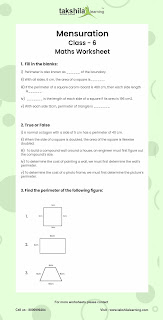Mensuration
Mensuration is a mathematical concept that involves, among other things, computing the areas, perimeters, and volumes of various geometrical objects. These shapes might be two-dimensional or three-dimensional. As a result, we learn to compute the areas, perimeters, and volumes of various two-dimensional and three-dimensional shapes. We accomplish so by employing algebraic equations and mathematical formulae.
Mensuration is a branch of geometry that deals with the measurement of sides and volumes. It goes over the fundamentals and properties of a variety of figures and shapes.
Mensuration, for example, can be used to calculate the length of cloth for sewing, the size of a wall to paint, or the amount of water needed to fill a tank.
Click on Types of Mensuration
Mensuration Worksheet for Class 6
I) Fill in the blanks:
- With each side 12cm, perimeter of triangle is _______.
- With all sides, 6 cm, the area of a square is______.
- If the perimeter of a square carom-board is 480 cm, then each side length is______.
- _______ is the length of each side of a square if its area is 196 cm2.
- Perimeter is also known as ______ of the boundary.
II) True or False
- To determine the cost of a photo frame, we must first determine the picture’s perimeter.
- When the side of a square is doubled, the area of the square is likewise doubled.
- A normal octagon with a side of 5 cm has a perimeter of 40 cm.
- To determine the cost of painting a wall, we must first determine the wall’s perimeter.
- To build a compound wall around a house, an engineer must first figure out the compound’s size.
Printable Worksheet for grade 6

Comments
Post a Comment
Thank you we will contact ASAP.